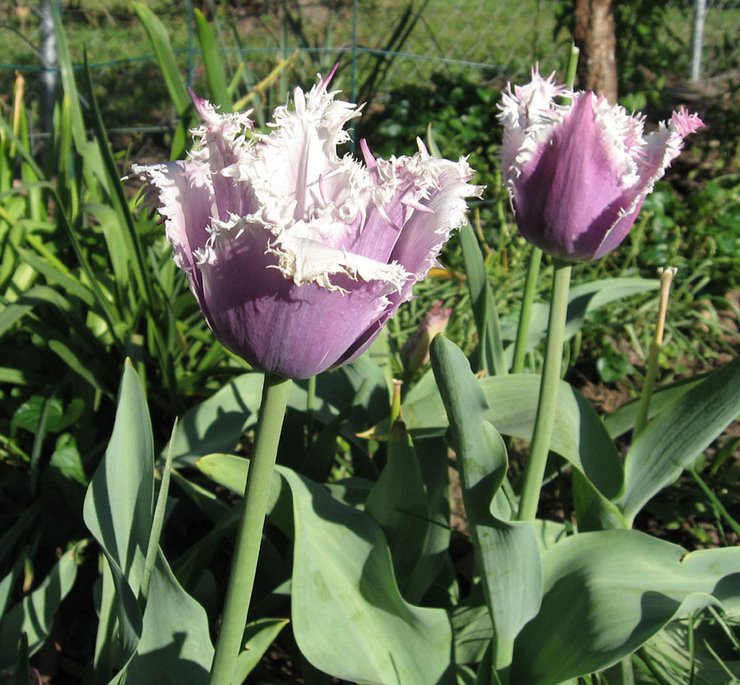I got a bit done in the garden over the weekend, as the temps on Saturday were pretty pleasant. We'd had a tiny bit of rain Friday evening, though not enough to really do much. I checked on the garden square I've been keeping sheltered under plastic. The peas are struggling, but the parsley seems to be doing fairly well. I clipped a handful of it for the bunnies, who were delighted to munch on that in addition to their lettuce.
In the next raised square, I had set up a wind break on the north side. The lettuce there is still not completely gone, though the cold nights have been hard on it. But I am still able to harvest a few leaves along on most mornings for the bunnies, as well as carrot tops.
I also opened the greenhouse up for a bit to air out, and watered the plants inside. Since it is only a single layer of plastic, and unheated, the plants inside are not kept that much warmer than outside, but it does make a difference. The parsley, mint, and strawberries are doing best at this point. The lettuce I'd planted in one large pot has shown no signs of growth yet. I watered everything, and sealed the greenhouse door back up before dark.
Sunday, December 16, 2012
Friday, November 30, 2012
Leaf Mold
I'm looking forward to getting out tomorrow to finish raking leaves. After raking them up into piles, I use my lawn blower/vac to grind them up into small pieces. You could also use a mulching mower, and collect the shredded leaves into the mower bag. Then I bag them up in large trash bags, moistening them a bit as I go, poke a few holes in each bag, and tuck them away in an out-of-the-way spot in the back yard for the winter. In about 6 months or so, those chopped leaves will have become leaf mold, an incredible soil conditioner for my garden.
Labels:
compost,
mold allergies,
mulch,
water conservation
Thursday, November 29, 2012
Late Fall Gardening
 |
| Late November harvest of bell peppers |
Now that we've had the time change from Daylight Savings Time, it's getting dark by the time I get home, so I have very little garden time except on the weekends.
Friday, November 9, 2012
Fall Garden Update
 | |
| Sweet and hot peppers picked November 9th |
Wednesday, October 31, 2012
Favorite Flowers: Snapdragons
 | |
| Lavender and white snapdragons |
Perennial, commonly sold as annual
Full sun, 10 inches - 4 feet
The snapdragon is a cool-weather plant, so now with the pleasant fall temperatures, my snapdragons are blooming profusely again. Since they can tolerate some frost, I plant them early in the spring, generally a couple of weeks before the last spring frost date. They bloom beautifully all spring and into the early summer. Then I trim them back, water them well, and see little from them until fall, when most will resume flowering.
Snapdragons are available in a wide range of colors, just about everything but blue, as well as softly-shaded bi-colors. They bloom along a flower spike, opening gradually from the bottom upwards. They have a light fragrance, and attract butterflies. Snapdragons come in various heights: dwarf ones that grow to about 10 inches, medium at about 18-24 inches, and tall that may reach 3-4 feet. I generally prefer the dwarf snaps, as they fit better into my flowerbeds, don't require staking as do the taller ones, and come in the largest choice of colors.
Saturday, October 27, 2012
Getting Ready for Winter
 | |
| Peas, marigolds and parsley in late October |
As flowers and vegetable plants die, I remove the dead plants, so they don't harbor insect pests or diseases over the winter. Perennial stems I cut back to ground level. A few things that offer valuable food for local birds, such as coneflowers, I leave until spring. Healthy plant stems and leaves can be shredded or chopped and added to compost, but anything that may have had any disease or pest problems should be put in the trash. I also watch out for any kinds of seeds. If your compost pile doesn't get hot enough, disease organisms, weeds, and seeds may not be killed during the composting process, and you'll just be multiplying these problems.
Monday, October 15, 2012
Favorite Flowers: Pansies
Allergy Index Scale: 1
Hardy Perennial, generally grown as annual, zone 4-8
Full sun, 6 - 9 inches
One of my favorite fall traditions is pansy planting time. Pansies are a classic fall and winter flower for the southern states, in planting zones six through nine. Mine bloom profusely all fall long, off and on in the winter, and then again throughout the spring. They give me flowers at times when everything else is dormant. Every winter I've seen them blooming cheerfully in the midst of snow.
Hardy Perennial, generally grown as annual, zone 4-8
Full sun, 6 - 9 inches
One of my favorite fall traditions is pansy planting time. Pansies are a classic fall and winter flower for the southern states, in planting zones six through nine. Mine bloom profusely all fall long, off and on in the winter, and then again throughout the spring. They give me flowers at times when everything else is dormant. Every winter I've seen them blooming cheerfully in the midst of snow.
Subscribe to:
Posts (Atom)
Fringed Tulips

